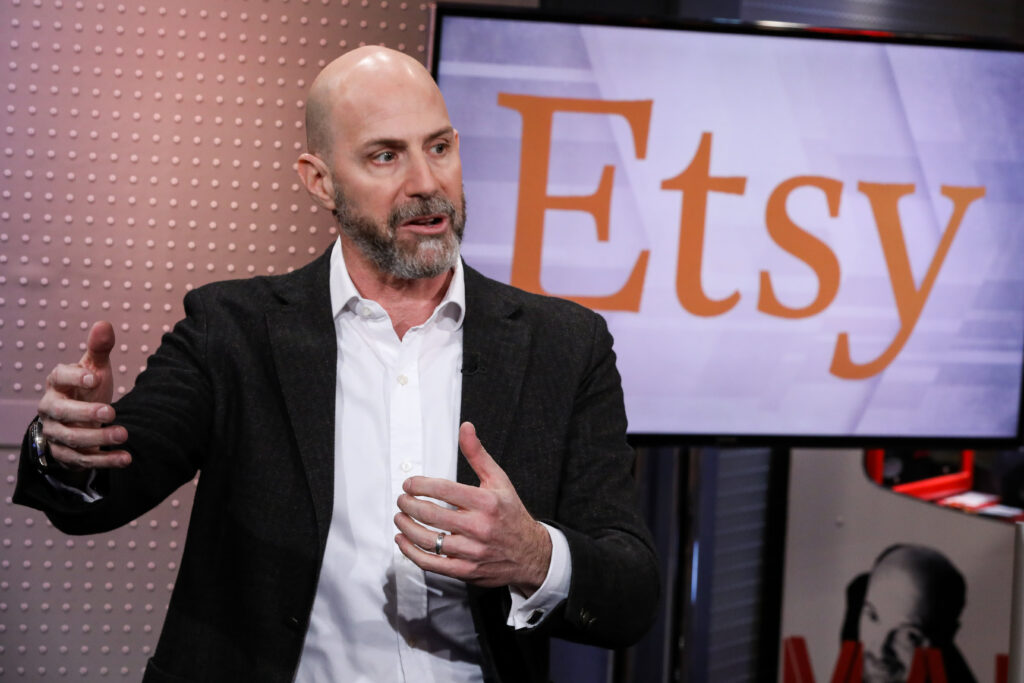Josh Silverman, CEO of Etsy.
Adam Jeffery | CNBC
The company on Tuesday will begin a major overhaul of the policies governing the site to make it “clearer” to shoppers which products qualify for Etsy, Silverman said in an interview with CNBC. The changes will include new labels appearing on the website and app that show how each seller created a particular product.
“By strengthening what makes Etsy Etsy, we're well positioned to meet that demand for original products and authentic people,” Silverman said.
Etsy is rolling out a new marketing campaign around the policy change, featuring TV spots featuring potters, dressmakers and other artists, followed by a broken robotic arm. The platform's new rules require all products to incorporate the “human touch” outlined in the company's creativity standards. Each item must fall into one of four categories: made by seller (by hand or with automated tools), designed by seller, hand-picked by seller or sourced by seller.
Etsy hopes the changes will lure buyers and sellers back to its site at a time when e-commerce is increasingly dominated by Amazon and Chinese startups such as Temu and Shein, which offer cheap goods delivered to your door within days. The stakes are huge, with eMarketer estimating the global e-commerce market to exceed $6 trillion this year.
“Right now, in terms of commoditized commerce, there's a lot of price competition, and it feels like just about everyone in e-commerce is in that race,” Silverman said. “They're trying to sell the exact same product two cents cheaper or deliver it two hours faster.”
Etsy has struggled to adapt to changing market trends. In the most recent quarter, total sales, the value of goods sold on its marketplace, fell 3.7% year over year to $3 billion. The company's shares have fallen more than 80% since peaking in late 2021. They're down 32% in 2024, while the Nasdaq is up 23% in the same period and closed at a record high on Monday.
In December, Etsy laid off 11% of its workforce, with Silverman citing a “very challenging macro and competitive environment” as the reason for the cuts.
Etsy NYC headquarters in New York City. The online retailer recently announced it would lay off 11% of its workforce as it restructures its business and streamlines costs.
Michael M. Santiago | Getty Images News | Getty Images
The company is also dealing with pressure from activist group Elliott Management, which owns about 13% of the company and is Etsy's largest investor. In February, Elliott partner Mark Steinberg joined Etsy's board of directors.
The rollercoaster ride began much earlier: Etsy went public in 2015 and was forced to respond to shareholder demands for growth that contrasted with the company's comfortable, socially conscious culture.
Etsy's business has exploded during the pandemic, fueled by a rush to buy masks: Its shares quadrupled in 2020, and the number of businesses selling on the site more than doubled to 9 million between 2020 and 2023.
Previously, Etsy used “house rules” to govern the site, with one basic policy being that “everything sold on Etsy must be handmade, vintage, or craft supplies.” Reselling was prohibited.
The new rules are more specific and updated to reflect today's realities. For example, 3D printed sculptures are considered “merchant-created.” Sellers are prohibited from sticking a single sticker onto a commercially available face mask and selling it as a handmade item. As for content generated by artificial intelligence, the policy states that “merchant-created AI art,” such as a dog in a costume, is considered “merchant-designed,” but digital downloads of “more than 5,000 ChatGPT prompts” are not allowed.
For years, Etsy has struggled to maintain its image as a place for unique, handmade goods while also expanding its product selection to compete with larger rivals, a change that hasn't always been welcomed by early sellers like Ashley Smith.
Smith began selling custom wedding handkerchiefs on Etsy through her business, The Polka dot B, in 2011. At the time, Etsy was a place where you could “search endlessly for amazing things people made,” but she said the site has since become dominated by general products.
Ashley Smith has been selling customized handkerchiefs on Etsy since 2011.
Ashley Smith
One of Etsy's biggest changes was when the company allowed sellers to use manufacturing partners in 2013. Sellers could now hire contract manufacturers to help with their products rather than making them themselves.
Abby Glassenberg, who opened an Etsy store for handmade stuffed animals in 2005, said the move has reduced her workload by allowing her to create patterns once and sell “endlessly.” Her Etsy store has gone from a hobby business to a full-time job, she said.
But many Etsy consumers still want a handmade experience, and Glasenberg understands the tension.
“Handmade can't be mass-produced,” she says. “That's why we love handmade. That's why humans love handmade.”
Grussenberg gives the example of a handmade fork, forged and cut by hand.
“We paid $120 for this, and we're going to use it and love it,” she said. “You can't make 100,000 of them a month, and that's why we love it.”
Abby Grusenberg has been selling stuffed animals and sewing patterns on Etsy since 2005.
Lisa Neighbors
But competing on a bigger stage is a different story, and Smith said the mainstream preference for cheap, quick goods “makes it harder for sellers and harder for Etsy.”
Temu and Shein have expanded their presence in the U.S. in recent years, luring American shoppers with deep discounts on clothing, jewelry, home goods and other products, and Silverman previously acknowledged that the sites are “taking a little bit of share from everybody.”
He is now making it clear to dealers and customers that the company will compete on its own terms.
“The solution for Etsy is to not play that game,” Silverman said.


